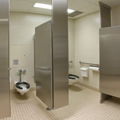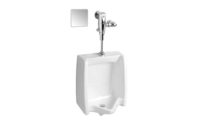Conditions play a role in choosing which type to use.

Diaphragm and piston flushing technologies have been around for decades, but plumbing engineers often still struggle with which one to specify. It’s really not about which one is “better.” Either diaphragm or piston could be the better choice, depending on the application. Although diaphragm flush valves are the right choice for the average commercial restroom, special environmental conditions may call for piston valves.
For some customers with multiple facilities, it’s not a matter of either/or; it’s both. The Charlotte Motor Speedway in Concord, N.C., sits on nearly 2,000 acres and includes a 2.5-mile road course, a 0.6-mile karting layout, a 0.25-mile oval within the walls of the 1.5-mile super speedway and a 0.20-mile oval. The speedway hosts three premium NASCAR events each year, plus more than 36 other events for automotive and motorsports fans.
Water conditions vary greatly between the speedway’s older and newer facilities, however. This made it necessary for the speedway to install both piston- and diaphragm-type flush valves.
“We have more than 1,000 Sloan flush valves of all types,” says Michael Gibson, head plumber at Charlotte Motor Speedway. Sloan Regal and Royal diaphragm flush valves are used in the main facility, which has 140,000 seats and 113 luxury suites.
Gibson adds the speedway uses Sloan GEM•2 and Crown piston flush valves in low-pressure and gritty water areas, including the Dirt Track of Charlotte and the zMAX Dragway, which are across the highway from the main speedway. The Dirt Track is a state-of-the-art 0.4-mile clay oval with 14,000 stadium-style seats. The zMAX Dragway, which boasts the world’s only four-lane all-concrete racing surface, has 40 suites and 30,000 grandstand seats.
Picking the correct flushometer technology for an installation calls for good, current information about how and where the valve will be used. And manual or electronic activation has nothing to do with the diaphragm vs. piston choice.

Technology overview
In a flushometer installation, water flows under pressure from the supply piping directly to the fixture. Because flushometers rely on the pressure and flow from the supply piping, more energy is behind the flush than in a gravity-fed tank toilet.
Diaphragm and piston flushometers fundamentally operate the same. Each has an upper control chamber and a lower chamber connected by a bypass. The bypass connecting the upper control and lower supply chambers in both the diaphragm and piston valves is a small hole or orifice that is no larger than a pin hole, typically measuring between 0.020 in. and 0.030 in. diameter. A flexible rubber disk separates the upper from the lower chambers in a diaphragm flushometer; a molded cup separates the upper from the lower chambers in the piston flushometer.
Both the diaphragm and piston include a number of components and design characteristics that control the rate at which the valve opens and shuts, as well as the amount of water that flows to the fixture during this operation. This allows both valve technologies to accurately deliver a controlled amount of water to the fixture under a variable range of water pressures and flow rates.
Know your conditions
When selecting and installing any flushometer, it is important that the valve model matches the pressure and water volume requirements of the plumbing fixture. The key to successful valve operation is to understand the type of installation and its environment, and then match the correct flushometer to the installation requirements.
There are three main factors to consider: restroom traffic, water quality and operating conditions.
In sports arenas and other high-traffic restrooms, the diaphragm technology can accommodate the quick recovery needed to immediately flush again, whereas low-traffic situations can benefit from either diaphragm or piston technologies. More information is needed to influence the optimal choice.
Another important consideration is water condition, because poor water quality often compromises performance and reliability. Dirty water, corrosive (salt) water, aggressive water, severe water conditions, treated water and low water pressure are all factors. Some characteristics of the water supply that affect long-term flushometer operation are:
These factors can cause wear and tear to the physical material of the flushometer. Piston deterioration is influenced by the sealing material composition and the operating water supply conditions. As the main piston lip seal deteriorates from constant abrasion, bowl flushing performance slowly decreases as the main high pressure seal becomes compromised and develops small leaks.
Diaphragm valves also can deteriorate as the constant flexing rubber material breaks down. As diaphragms age they may become more flexible, causing more water to be delivered as the elastomer continues to yield with wear. The main surface area or seat may begin to weaken, adding very small distances to the relief valve travel and more water to each flush.
Harsh operating environments can cause a flushometer that is not engineered to perform under these conditions to malfunction or operate at low efficiency, which wastes water. Operating conditions, such as the following, can affect flushometer choices:
-
A system could have a very high static pressure condition but not recover quickly after a flushometer initiates a cycle, and the system struggles to recover to the high initial pressure.
-
A fixture downstream of the flushometer may have very extreme back pressure coming back up the vacuum breaker tube, affecting the metering device.
The piston technology has stronger capabilities in low pressure and weak system situations. For a high pressure system, the diaphragm may be a better choice.

Evaluation points
Because varying influences affect whether a diaphragm or piston valve is the better fit, select the optimum technology by using a checklist of operational conditions (visit www.pmengineer.com for this checklist). As you’ll see, however, diaphragm flush valves work across a wider range of operational conditions, making this technology the right choice for the majority of restrooms.
High-efficiency fixture performance is another variable that narrows the flushing technology choices. Although both diaphragm and piston technologies have high-efficiency options, more choices are available with diaphragm.
The key to making the better choice between diaphragm and piston technology is understanding the application and knowing each technology’s strengths. It is not a one-size-fits-all type of solution or a matter of one flushing mechanism being better than the other. Both technologies are excellent in the right situation.


